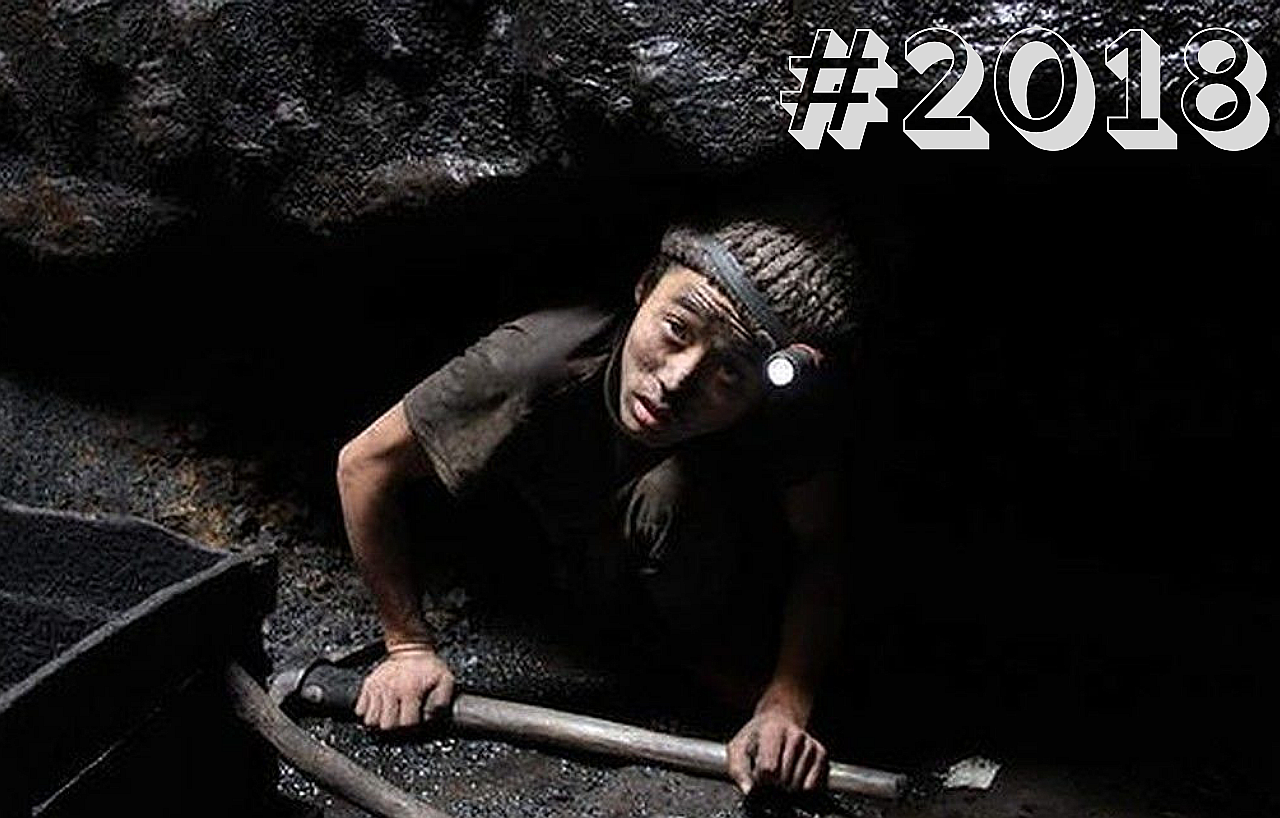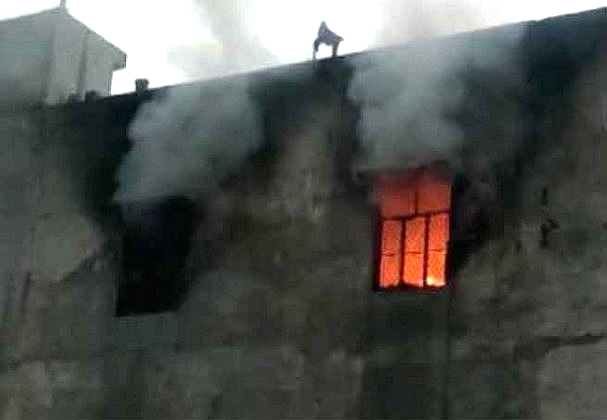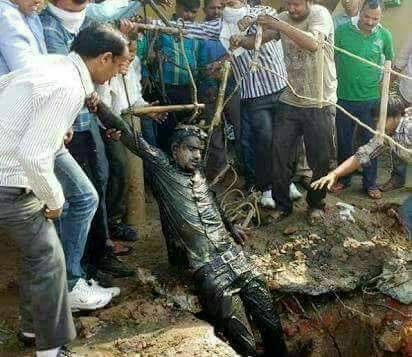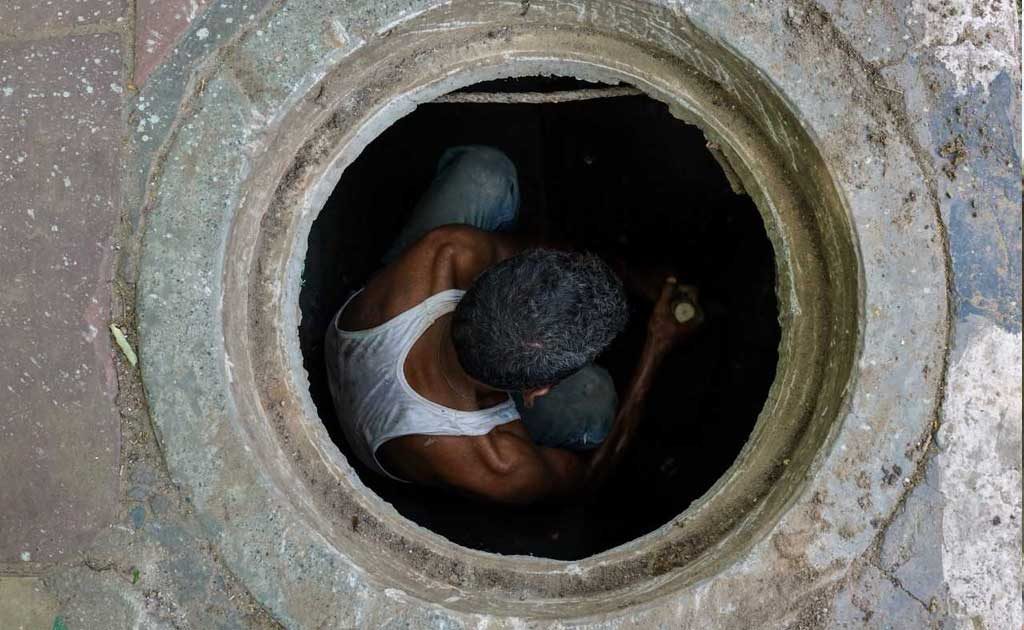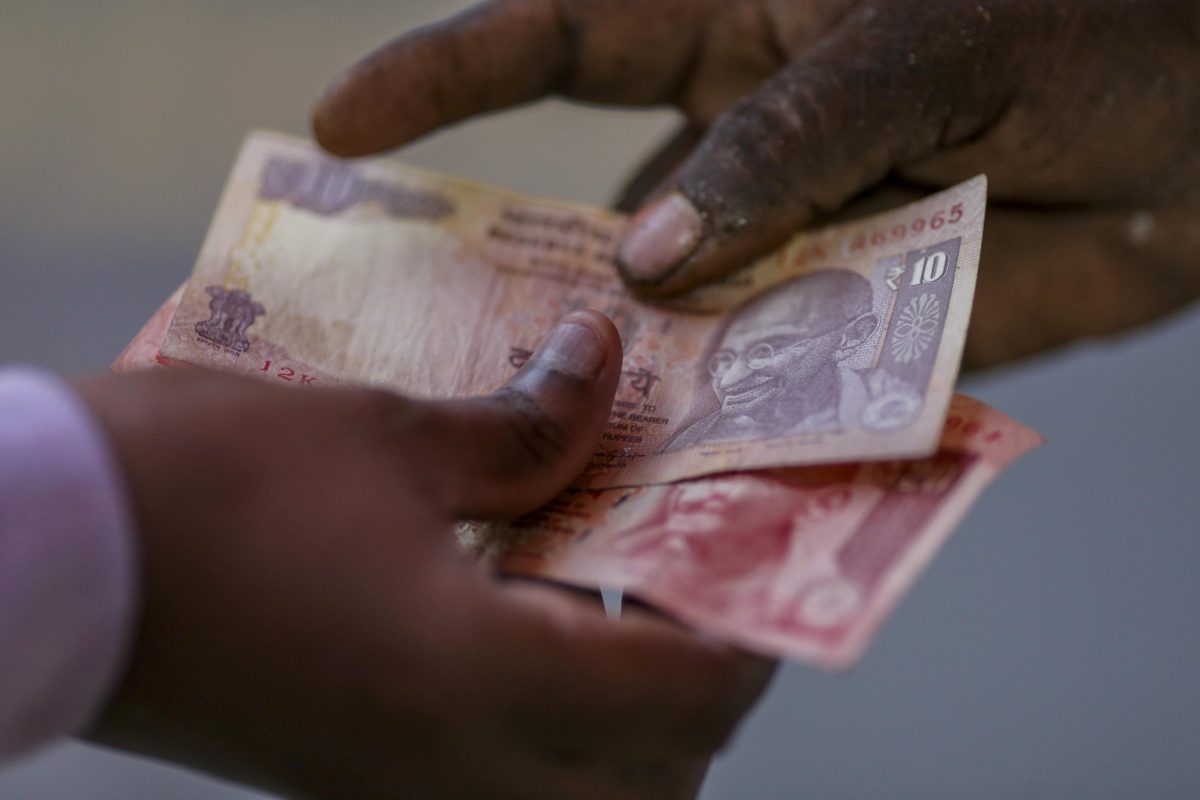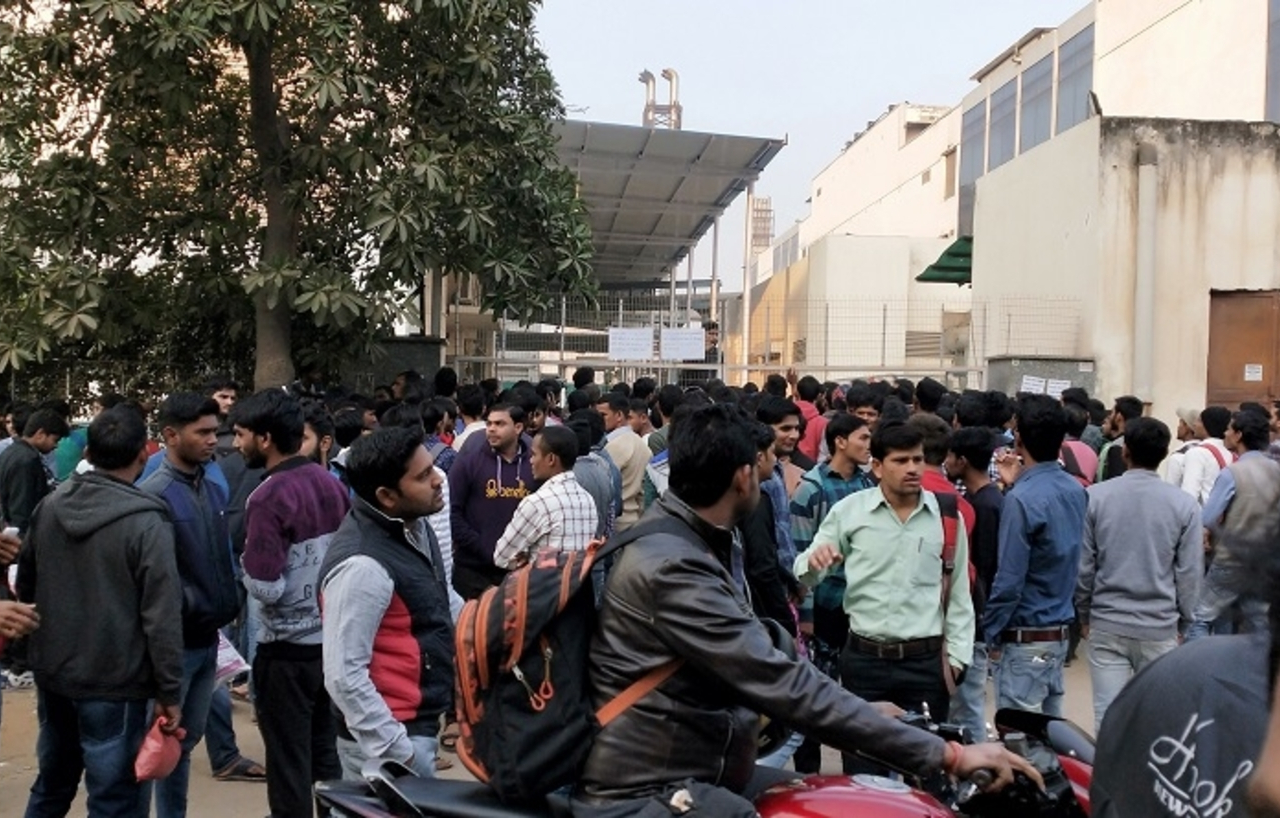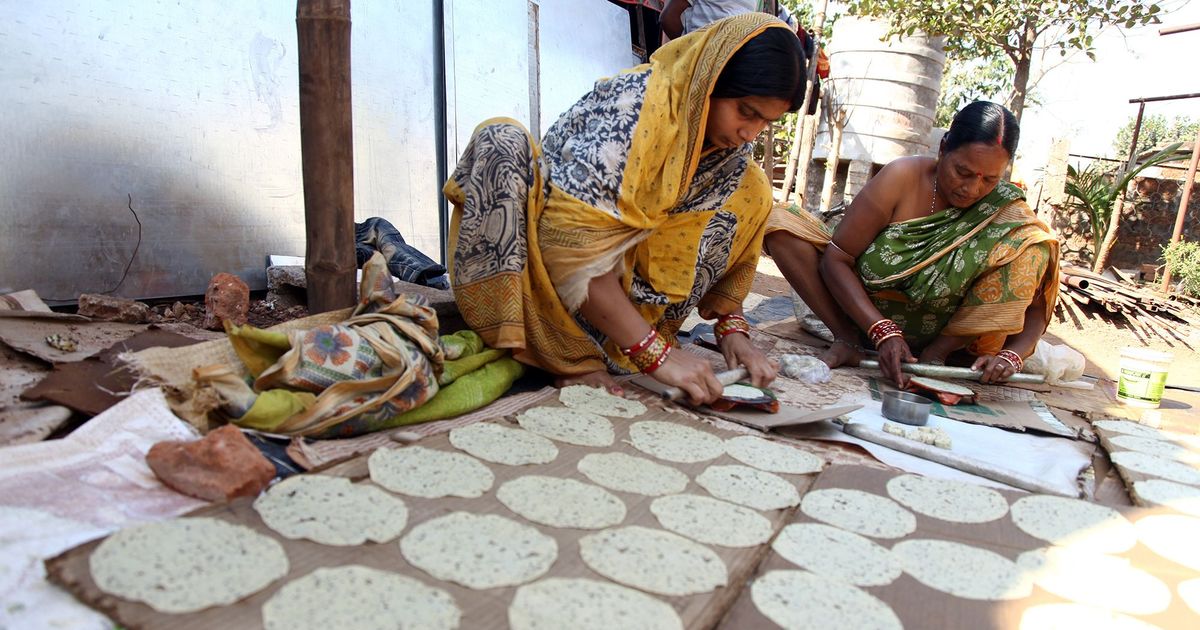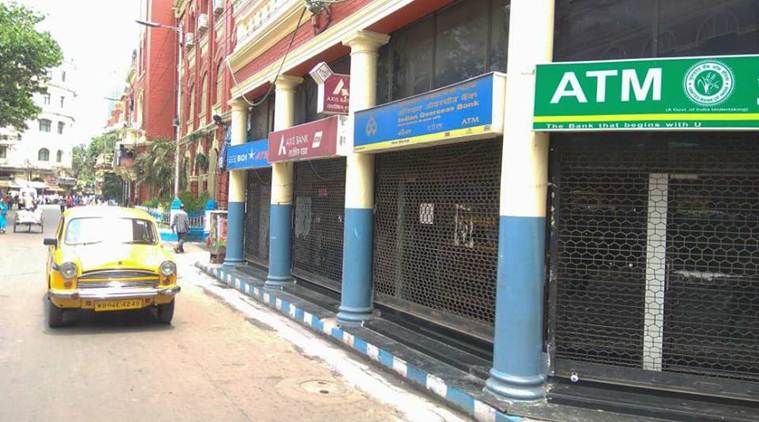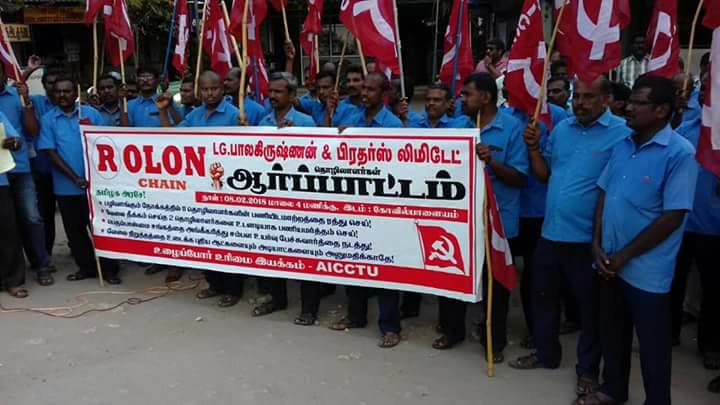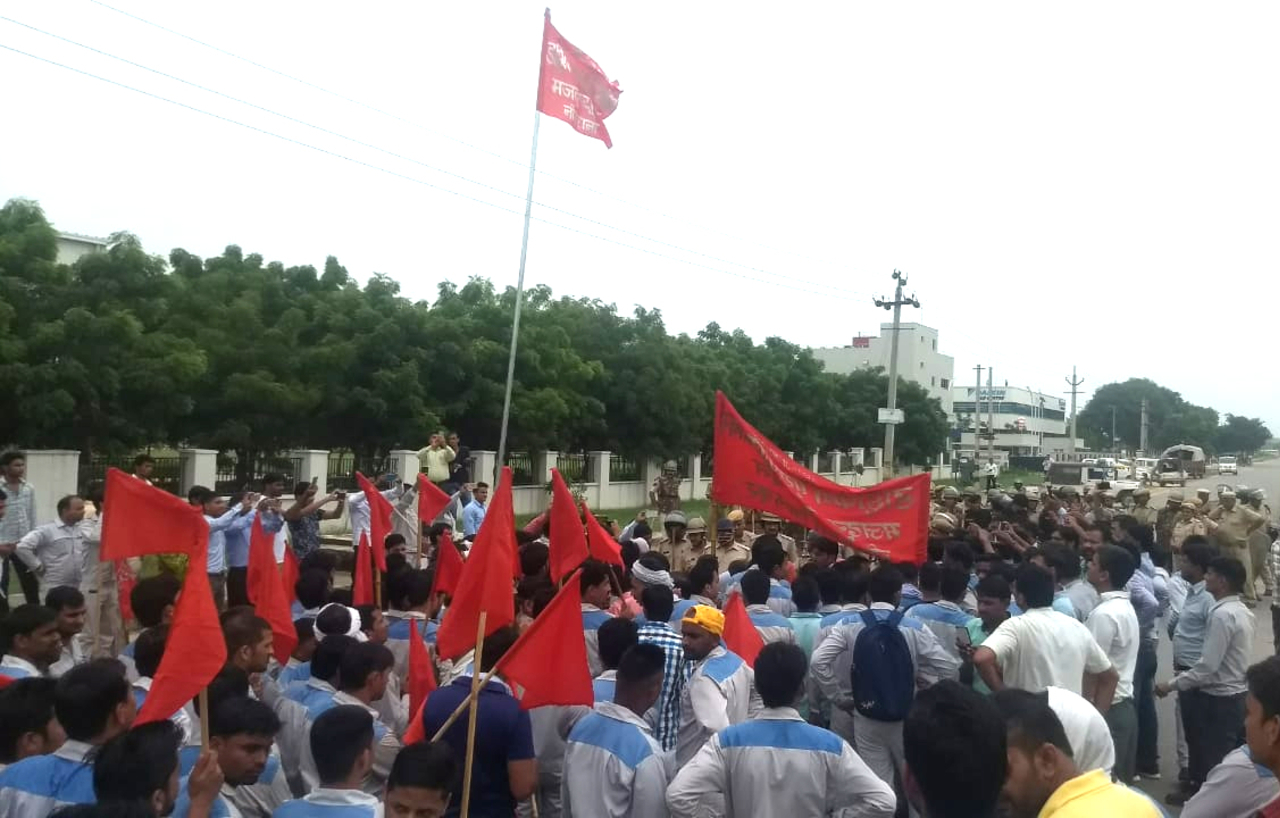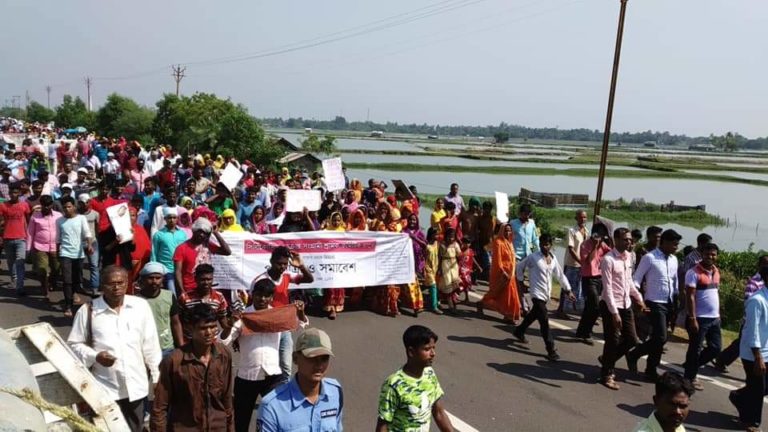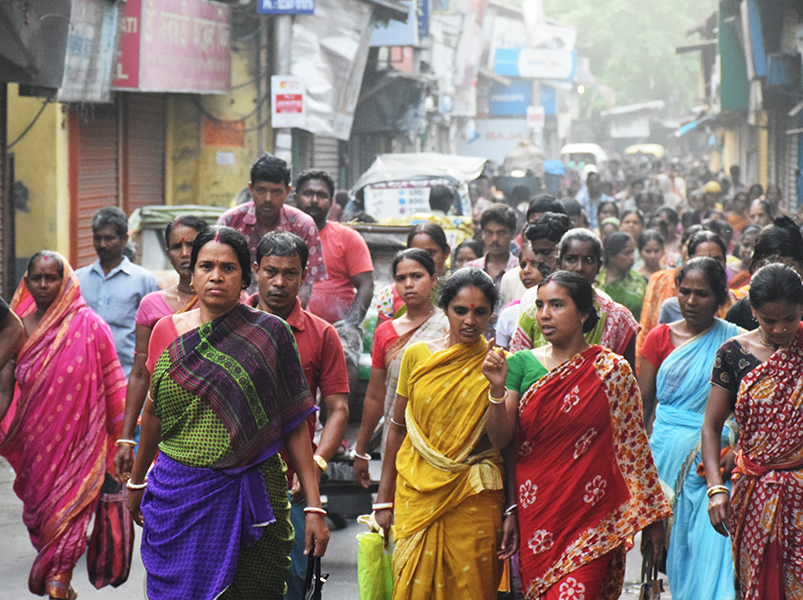Narendra Modi had promised the country’s workforce one crore jobs a year through “Make in India”, etc. But the self-proclaimed ‘Mazdoor No.1’, after occupying the throne, promptly pushed on the gears of neo-liberal crony capitalist extraction that was initiated by his predecessor Manmohan Singh. 2018, being the final year before the next General Elections, had to be crucial for a complete handover of the economy to big corporates – the ones who bank-rolled the current Government into power. Sure enough, 2018 witnessed the final push for labour law reforms that begun in 2014. Permanent jobs were ever increasingly replaced by contract, Unionizing rights of workers were trampled upon, working hours steadily increased, labour laws were blatantly violated. Illegal lockouts, closures, lay-offs, retrenchments, growing unemployment grew at alarming rates.
But 2018 was also a year of relentless workers’ struggles across the country against attacks by the State-Corporate nexus. We saw workers and their families take on the mighty empires despite being attacked with police brutalities, draconian colonial laws and life imprisonments. We saw nurses and ASHA workers taking to the streets, domestic workers organise, permanent workers come in support of their contract-bound colleagues. We saw farmers and workers march shoulder to shoulder in the nation’s capital demanding their rights. We saw Karl Marx remembered and re-engaged with on his 200th birth anniversary by North Bengal tea workers fighting for minimum wages, and workers across industrial belts of Gurgaon-Manesar, Rajasthan, Tamil Nadu rise up in protests from one factory to the other. This is a GroundXero throwback into the year that saw the worst attacks on workers’ rights in recent times, but also the year that saw the workers fight back with everything they have.
Trapped in the ‘Rat Holes’
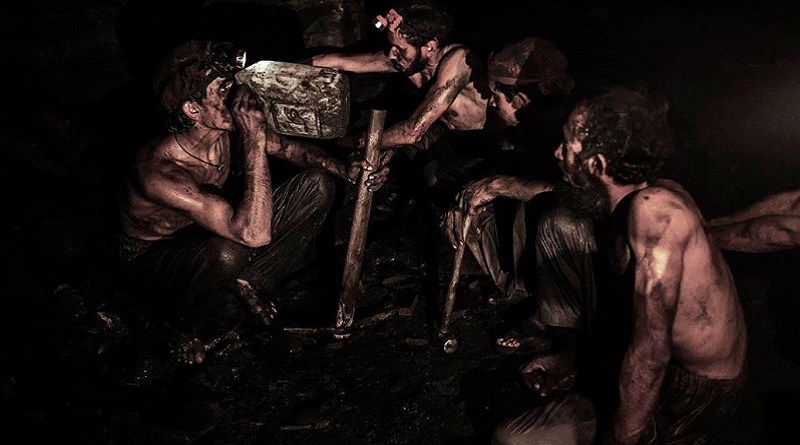
Courtesy: WorkersUnity
An ongoing tragedy in Meghalaya cynically sums up the year-long experience of the working class across the country. Since 13th December, 15 miners have been trapped inside a coal mine in Meghalaya’s East Jaintia Hills that got flooded with water following a sudden collapse. Slow and inadequate rescue operations have drowned all chances of the miners coming out alive. Locally available pumps were not strong enough to pump out the water. The State and Central Governments continued to exchange letters and blames on the need to get more powerful pumps. Narendra Modi strutted along a newly opened bridge in Assam on December 25, posing for the cameras, but did not care to visit the site of tragedy in the neighboring state. Completing the irony, on Jan 2nd, the Supreme Court finally ‘agreed to hear a petition’ seeking adequate manpower and equipment for the rescue ops, while the miners remain trapped.
The National Green Tribunal (NGT) had imposed a blanket ban on mining and transportation of coal in the state in 2014. Coal mining in Meghalaya has been known to be extremely unsafe, because of its outdated and dangerous methods. Small tunnels of 3-4 ft diameters called “Rat Holes” are dug, so that only one person can barely fit in and dig up coal. Illegal mining in the state has continued even after the ban, and the annual turnover has been estimated to be Rs 700 crores, forming a significant source of electoral funding in the state. Hundreds of these illegal mines are owned by political leaders from across the spectrum and their family members, including several cabinet ministers and law-makers from the state.
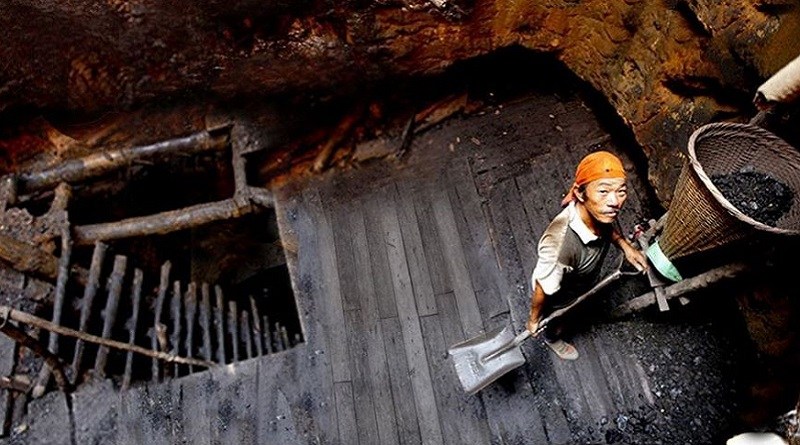
Courtesy: WorkersUnity
While Indian media did constant wartime coverage on the rescue of a group of young men trapped in a Thailand cave in similar fashion, they could not find space to talk about trapped miners in their own country. The Congress has taken the opportunity, even as the miners are still trapped, to blame the fatal working conditions on the NGT ban, and demanded for “legalising” the mines. The BJP has for long used the promise of lifting the ban, earning electoral mileage in the state. Meghalaya is currently ruled by the Meghalaya Democratic Alliance that includes the BJP.
131 workers died daily inside the country, 20 outside
The Meghalaya crisis is hardly isolated. According to official data presented in the Lok Sabha earlier this week, as many as 377 mine-workers died between 2015 and 2017 in the country. A British Safety Council report from November claims, only 20 percent of the 465 million-strong Indian workforce are covered under health and safety legal framework. Quoting the International Labour Organisation numbers, the report says that 48,0000 workers die in the country per annum due to work-related hazards. This means 131 workplace deaths everyday in the country. The same report also mentions that there is only one factory inspector for every 506 registered factories in the country.
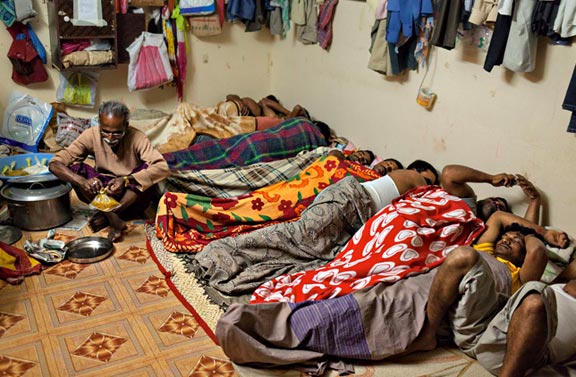
Guest workers from Uttar Pradesh, India, crammed into their sleeping quarters in Dubai, UAE. Source: National Geographic, Photo: Jonas Bendiksen.
The condition of the Indian worker is no better outside the country. In this Winter Session, the Government told the Parliament that as many as 28,523 Indian workers have died in the Gulf countries, including UAE, Bahrain, Oman, Qatar and Sadi Arabia over the past 4 years. This amounts to almost 20 deaths per day. According to reports, Indian workers in the Gulf countries account for almost half of the total foreign remittances to the country. From 2012 to 2017, Indians working on foreign soil sent home around $410.33 billion. Out of this, $209.07 billion were sent by the workers from these Gulf countries.
Factories on Fire
Back in the country, on January 20, a plastic factory in Bawana Industrial Area of New Delhi caught fire. While initial reports claimed the death of 17 workers, a fact finding report found out that the actual number of workers burnt alive was more, and could have been as high as 29. The factory building had only 2 fire extinguishers, and not a single smoke detector, smoke alarm or water sprinkler. It was discovered that the factory was being used to store explosives and illegally manufacture fire crackers. The main gate would be kept locked and the workers would be forced to work inside. The Labour officials took no steps to prevent these illegal practices although the factory owner was a known violator of labour laws. Few days before this incident, one factory in west Delhi’s Peeragarhi was gutted in fire. Four people were critically injured after a fire broke out at another plastic factory in Sriniwaspuri, around the same time.
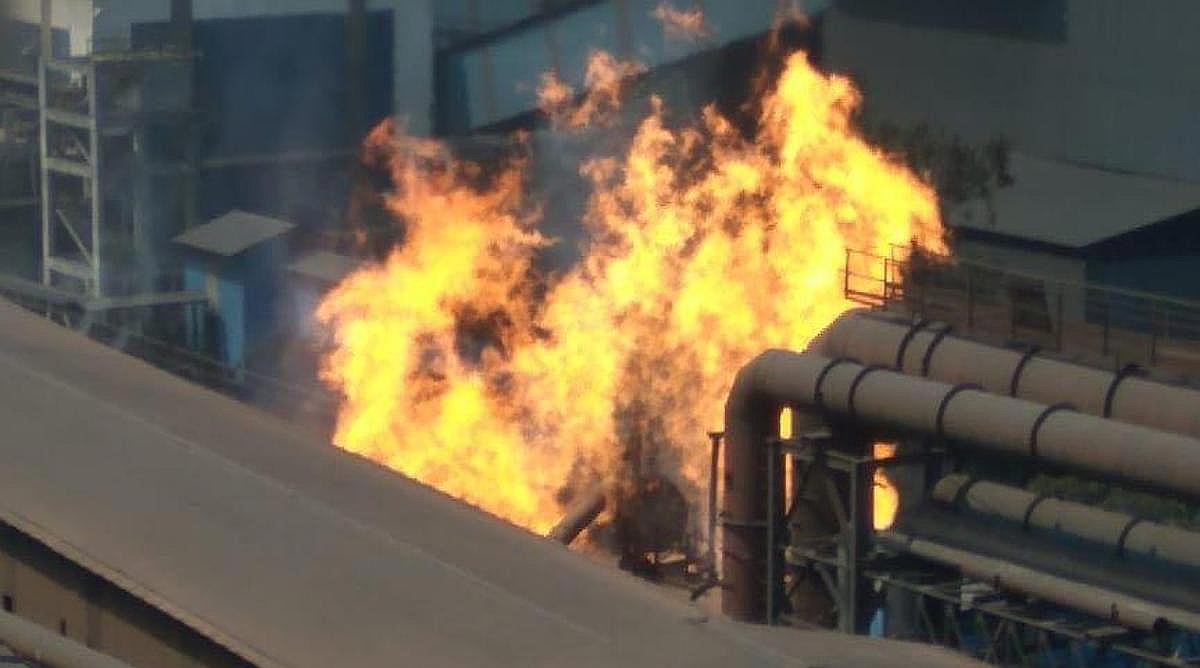
Bhilai Steel Plant fire killing at least nine persons and injuring several others on Oct 9, 2018. Photograph provided by an anonymous worker working at the Bhilai Steel Plant.(Photo: IANS/ Courtesy: The Statesman)
In October, the Steel Authority of India Limited factory in Bhilai caught fire after a coke oven battery complex exploded, killing at least 9 workers then and there, and critically injuring many others. At least 2 more workers died later during the day. In September, six people were killed and eight critically injured when a liquid methane tanker exploded at a petrochemical factory in the Bijnor district of Uttar Pradesh. In March, three labourers were burnt to death and at least six others sustained injuries in a devastating fire that broke out in three paint manufacturing units in Sonipat. On 5th October, a Junior Engineer at the Maruti Suzuki factory at Manesar tried committing suicide by slitting his own throat within the factory premises, buckling under regular insults and humiliation from the factory management.
Manual Scavenging: The Skeleton in the closet of ‘Swachchh Bharat’
On 9th September, five workers died while manually cleaning a septic tank in Delhi’s Moti Nagar. The incident happened in a posh residential complex called DLF Capital Green. The workers were employed by an American company JLL with billions of dollars yearly turnover, through a private contractor. According to an Indian Express report from October that was pushed to the bottom corners of Delhi edition of the newspaper, 16000 sanitation workers in Punjab work on a salary of Rs 300 per month, and the last time they got paid even this was in 2014. “The lack of a living wage has cast a shadow on the central government’s ambitious Swachh Bharat campaign. The Punjab government began paying the honorarium since 2007, which has been held up since 2014. Though in June this year, the Rural Development and Panchayats Department of Punjab released Rs 4.69 crore to 13,018 Gram Panchayats as one year’s (2018-19) stipend, the money hasn’t reached the workers,” said the report.
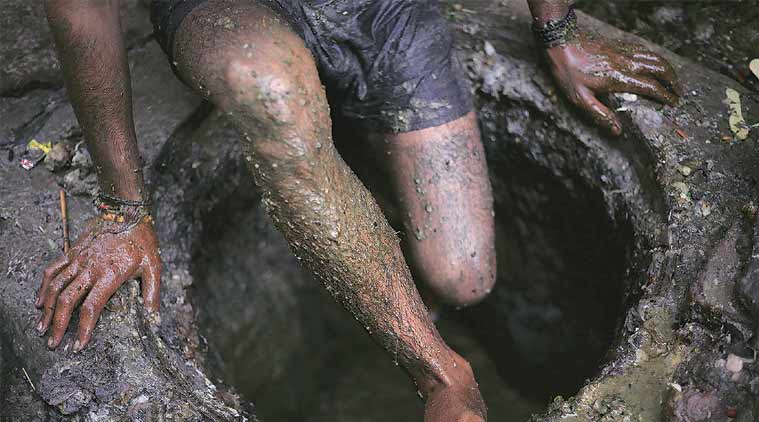
Courtesy: Indian Express
According to a WorkersUnity report, every hour 3 people employed in manual scavenging died on an average last year. Close to one person on an average dies inside a manhole every day in the country. Most of these recorded deaths (almost a half of them) were registered in Tamil Nadu, followed by Karnataka, UP and Delhi. Even in 2019, India remains the only country in the world where the task of manual scavenging is reserved for only one community – Dalits. The occupation was outlawed in 1993, and another law in 2013 reinforced this ban and recognised cleaning of sewers and septic tanks as manual scavenging. But the death count only increased over the years. Since January 1, 2017, one person has died every five days, on an average, while cleaning sewers and septic tanks across the country, according to numbers collated by the National Commission for Safai Karamcharis (NCSK). According to 2018 news reports, a Central government task force counted 53,236 manual scavengers in just 121 out of the country’s 600 plus districts – a four-fold increase from the official statistics from 2017 (Out of this National Survey figure, only a total of 6,650 have been confirmed officially by the State Governments, keeping up the tradition of under-reporting these numbers). The actual number across the country is estimated to be much higher than this, going into several lakhs. Bihar, Jammu and Kashmir, Jharkhand, Karnataka, Telangana and West Bengal did not participate in the survey.
In October, three workers died of asphyxiation while cleaning a sewage tank at a Delhi Jal Board pump-house. The public body quickly shifted the blame onto the private contractor who had been outsourced with the cleaning work. According to an Indian Express report, over 20 sewer deaths happened in Delhi alone over the last one year.
Bonded Labour continues with impunity, 42 years after being banned
Couple of weeks back, 52 bonded labourers belonging to SC, ST communities, were rescued in Karnataka. According to a Newsminute report, they were enslaved and whipped into grueling 17-hour work days. The labourers were rescued after one of them managed to escape. Kept under lock and key and supervised at all times, the adults were made to do arduous manual labour in the agricultural fields from 4-5 am in the morning to late in the night. The women workers were subjected to sexual violence under captivity. A survey conducted by the NGO International Justice Mission estimated that out of a total number of 16 lakh labourers across three districts of Karnataka, about 33% could be bonded labourers. About 92% of these labourers belonged to the SC/ST communities. The industries where this is most prevalent includes brick kilns, plantations, rock quarries, rice mills, tobacco and fish farms. There was evidence of trafficking in 59% of bonded labour cases. “On August 30, 2017, Harish [a bonded labourer]’s former employer Paaruvangada Kishan allegedly hunted him down, beat him, and set three dogs on him,” read a Newsminute report from late 2017 that talked about rampant use of bonded labour in the coffee plantations of Coorg. Bonded labour had been outlawed in the country way back in 1976, but continues unabated even today in 2019.
Attacks on Labour Laws, Attacks on Labour using Laws
Sealing off an entire year of labour law reforms, Narendra Modi proposed the abolition of the offices of the Labour Commissioners and Labour Inspectors, replacing these with ‘Facilitators’. This is not merely a change of names, but a full and final abolition of the already waning powers and jurisdictions of the Regulatory bodies. This is part of the Government’s plans to replace the nation’s 44 labour laws with 4 ‘simplified’ law codes in order to ‘ease business’ and end ‘Inspector Raj’. According to the Trade Unions, this is the biggest attack so far on the labour rights that workers’ struggles in the country have won through hard fought battles over decades. These proposals have been brought as part of the Draft Code on Social Security and Welfare – one of those four ‘simplified codes’. The new ‘Facilitators’ will not have suo motu powers to inspect the companies for labour law violations. They will only be allowed to ‘issue notices’. In case of accidents or other emergencies, the Facilitators will have to inform the management before launching an enquiry, and the investigation reports can not be made public.
“The Centre will spare no effort to push through some key labour reforms in the new year … The labour ministry is already in the process of seeking the Union Cabinet’s approval on amended Wage Code Bill after its vetting by the parliamentary standing committee, so that it could be pushed for passage in Parliament … Similarly, the Ministry of Labour and Employment is keen to push the passage of Code on Industrial Relations, in the run-up to the 2019 polls,” reported the Economic Times this December.
While labour laws are being quickly erased, anti-labour laws from colonial times are still in rampant use. 13 workers of Maruti-Suzuki, 4 workers of the Graziano auto factory in Greater Noida, 2 workers of Pricol (Coimbatore) are still in prison under life sentence. In January, 5 Reliance workers in Mumbai were arrested by the Maharashtra ATS and charged with UAPA. They were released last week, after almost a year in jail. Earlier, the movement of the workers of Reliance Energy had been attacked using the colonial Essential Services Maintenance Act (ESMA).
Vanishing Jobs, Stagnant Wages, Outlawed Unions
Such attacks on conscious workers are a backlash on workers’ movements brewing across the country – a phenomenon that gathered steam throughout the year. These movements have sprung up on the questions of stagnant wages, non-payment of minimum wages, arbitrary job cuts, lay offs, and the right to organise, among other things.
According to Labour Bureau data, real wages of agricultural labourers have grown at the rate of a mere 0.77% per annum over the last 4 years. For non-agricultural labourers it was 0.02% per annum. For construction workers, who form among the largest group of workers outside agriculture, real wages during the same period in fact declined by 0.24% per annum. For all agricultural occupations together, the growth rate of real wages during this period was a meagre 0.55% per annum. “Since November 2016, real wages of casual workers are almost stagnant with almost no growth. It is important to note that the current spell of stagnation in real wages is the longest and the worst in the past three decades,” according to a recent LiveMint report. According to an end of the year report based on the Labour Bureau data, the number of people laid off from their jobs has increased by around 25 per cent from 2016. While a total of 3,654 people were fired in 2015, the number rose to 4,200 in 2016 and 5,249 in 2017. In 2018, till the end of August, a total of 3,322 people had lost their jobs. In Gujarat alone, at the turn of the new year, around 7000 contract workers working for 10 years in the Income Tax department, reportedly lost their jobs. 7 factories were shut down over the year in the Gurgaon-Manesar industrial belt, leaving 2300 workers jobless.
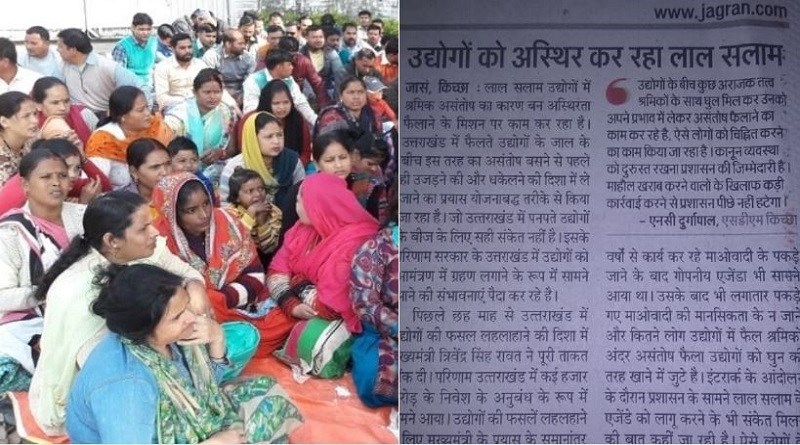
Striking workers and media demonization. Source: WorkersUnity
303 permanent workers of Micromax factory in Uttarakhand were laid off because of their attempts to unionize. Protests erupted, and around 250 employees sat on a dharna in protest, inside the factory itself.
In September, the management of Uttarakhand’s auto-parts manufacturing plant Spark Minda, removed 150 young men and women from the workforce. The laid off employees have been sitting on a protest dharna ever since, in front of the Deputy Labour Commissioner’s office. The clashes between the workers and the management began when 10 workers were forcefully removed by the company for trying to register a Workers Union.
On November 29, around 1,200 workers of the Hi-pad Technology India at Noida, which makes Xiaomi and Oppo phones, went on protest against en-mass sacking of workers without any notice. Over and above meager wages of Rs 9700 per month and arbitrary lay-offs, the company had offered Rs 1.5 to Rs 2 bonus for Diwali, adding salt to injury.
Earlier in the year, the AAP Government of New Delhi proposed a minimum wage calculation assuming a monthly house rent of Rs 874 – an amount that is nowhere enough to even renting a jhuggi in the metro!
In the last week of December, Ola and Uber drivers in Kolkata went up in spontaneous protests and strike against the predatory business policies of the online cab companies. Earlier, there had been similar protests in other metros like Mumbai, Delhi, Hyderabad and Chennai.

JNU women sanitation workers struggling for equal pay. Source: WorkersUnity
In November, the JNU administration removed a woman sanitation worker for demanding equal pay as her male colleagues. Earlier, the already meager salary of JNU security guards working under the agency G4S had been slashed by the administration without any prior notice, in the pretext of the Delhi Government’s revision of minimum wages. Workers and students in the University had raised their voices in protest against this move.
According to a study conducted by HomeNet South Asia, around 3.74 crore home-based women workers in India labour for 21 to 29 days a month to earn approximately Rs 6,000 on a piece-rate basis, spending six to eight hours a day stitching sleeves, sewing buttons, trimming threads, attaching drawstrings, and crafting embroidery. While in Delhi, the tasks mostly included embellishment work and embroidery leading to a daily earning of around Rs 70, in Tamil Nadu it was more like trimming or stitching sleeves and buttons at 30 to 75 paise per piece. The reported earnings were merely enough to get the families’ ration supplies.
2018: A Year of Workers Fighting Back
The highlight event of the year in terms of workers’ mobilizations, was perhaps the Joint March of Farmers and Workers that stormed the capital city, in the month of September. Thousands of workers and farmers from different states marched to New Delhi to protest the government’s anti-people policies, calling for fair wages and debt waivers. In what many called the “biggest rally of the working people that Delhi has seen in decades”, workers rallied outside Parliament Square to demand the effective implementation of labor laws. People from different areas flocked to the capital and camped at Ramlila Maidan before marching to Parliament against the government’s policies, which they branded the “common enemy” as they only profit big corporations.
Other than the mega event however were a year-long, country-wide relentless buzz of workers’ agitations across various sectors. Below is only a short sample list:
21st December: Officers’ Unions across public sector banks went on a country-wide one-day strike against lay-offs and wage settlements. The issue of wage hikes for bank employees has been hanging in negotiations for as long as 14 months now. Another strike was called within a week, when bank employees went on protest against the Modi Government’s decision to merge Vijaya Bank and Dena Bank with the Bank of Baroda. “Experience shows that previous bank mergers led to closure of branches, increase in bad loans, reduction of staff, etc.,” said a statement from the World Federation of Trade Unions on the issue of the merger.
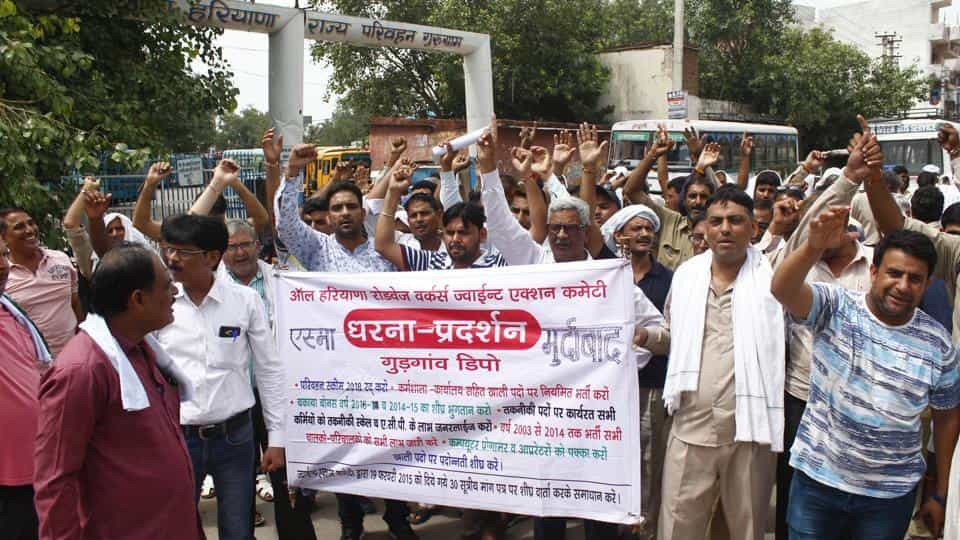
Haryana transport workers’ 18-day strike. Source: Hindustan Times
November: After sustained struggles for several months, workers in the NCR region forced the Delhi Government to announce a hike of 37% in minimum wages. Though the Delhi High Court stayed the pay hike, the Supreme Court overturned the stay last month. In Haryana, thousands of transport workers went on an 18-day strike – the longest such strike in the history of the state – to protest the corporation’s decision to hire 700 buses from private owners.
August: In northern West Bengal, tea workers across hundreds of tea gardens repeatedly went on production and supply strikes asking for minimum wage implementation, and putting an end to the traditional 3-yearly tripartite wage fixation. Though the movement hasn’t yet succeeded in its stated goal, it did take the discourse around tea workers’ struggles beyond only closed plantations and starvation deaths.
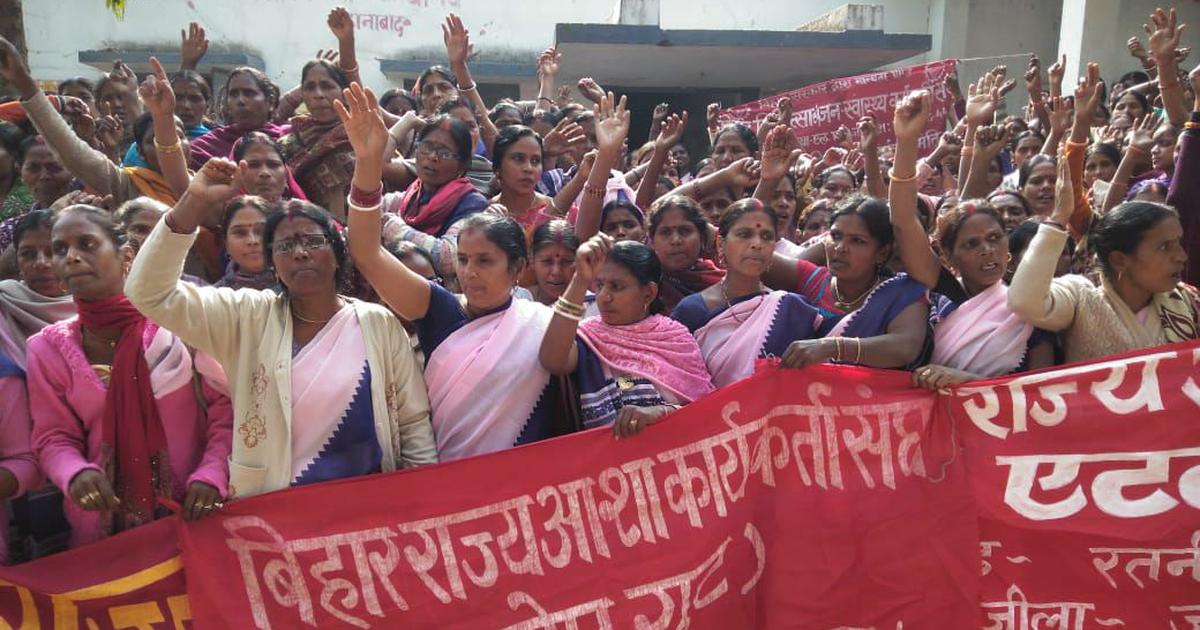
Source: Scroll.in
December: Accredited Social Health Activists or ASHA workers in Bihar went on an indefinite strike from December 1 with a 12-point charter of demands. Bihar has 93,687 ASHA workers – the second highest contingent of the one million such workers in the country. On December 13 and 14, they laid unbroken siege to the Bihar Chief Minister’s office, pointing out that the state has not implemented its own agreement of June 2015 with ASHA unions. They are demanding government employee status and a minimum wage of Rs 18,000.
ASHAs are unpaid workers. The National Rural Health Mission says that the ASHA is an “honorary volunteer and would not receive any salary or honorarium”. There are no regular working hours and the ASHAs are expected to be on call 24/7. They are expected to arrange and pay for their own transport to the health centres and hospitals. A recent survey of ASHA workers in Delhi found that they may spend up to 12 hours a day on the job, including transport time. Incidentally, the Indian Government spends less on healthcare than Nepal, Maldives, Sri Lanka and Bhutan – a pitiful Rs 3 per day per capita.
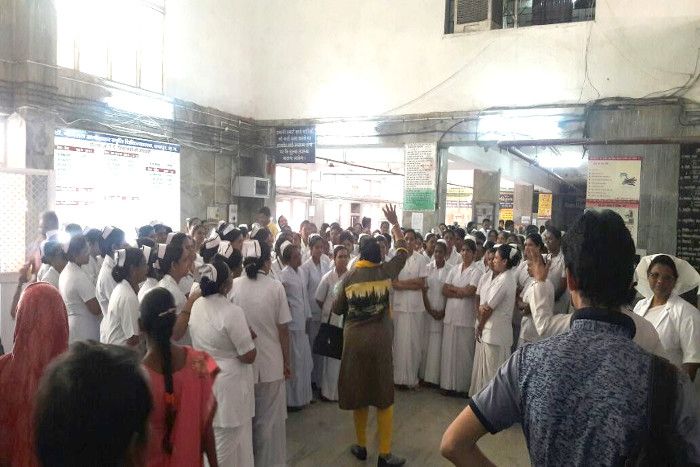
Source: Patrika.com/ Photo: Chandu Nirmalkar
Earlier, in May, thousands of nurses in Raipur, Chhattisgarh went on a hunger strike demanding pay scale revision and promotions. The striking nurses were brutally attacked by the police, around 600 of them were jailed, and charged with ESMA.
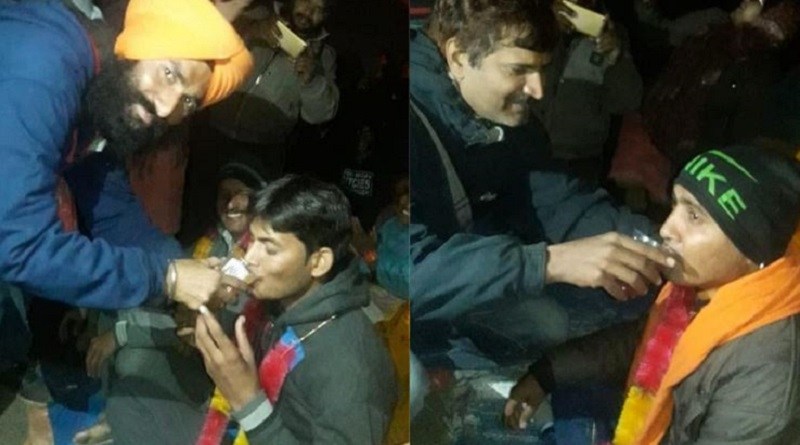
Source: WorkersUnity
December: In Uttarakhand, after 87 days of struggle, workers of the Interarch Buildings Private Limited won significant victory. The company management agreed to the demands of reinstating laid off workers, and to paying due wages and bonus amounts. The production manager of the company had allegedly claimed earlier, “I am an RSS-BJP man, no body can do anything to me.”
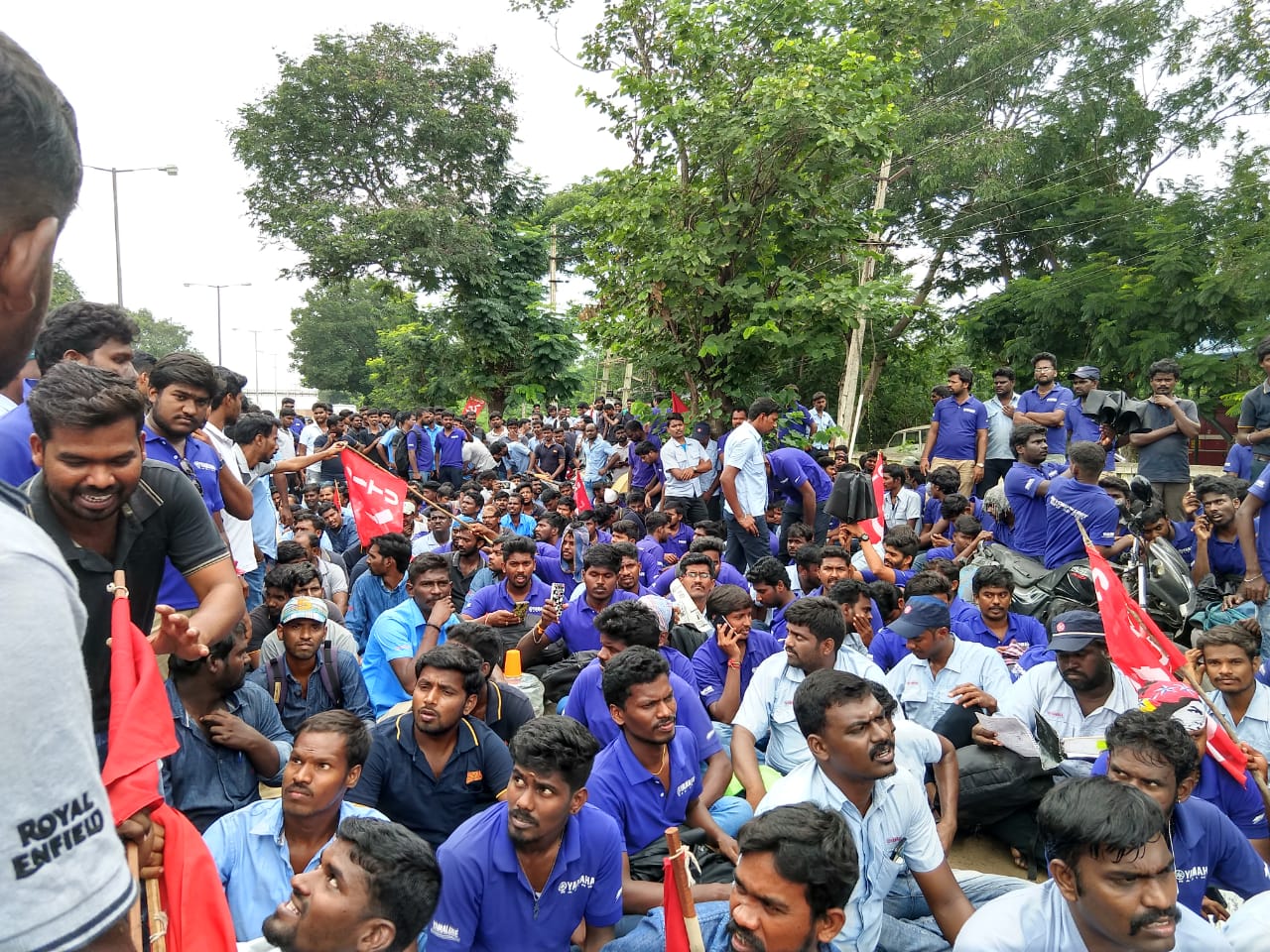
Royal Enfield workers on strike in Tamil Nadu. Source: TNLabour
September: In Tamil Nadu, workers at Yamaha, MSI and Royal Enfield plants went on strike against their respective managements. The Royal Enfield workers’ strike lasted for 50 days despite police crackdown, particularly on women workers.
Workers at Microlabs, a factory in Hosur, have been on a prolonged struggle for union recognition, battling against intimidation and arrest of union office bearers. Women workers here have been complaining about excessive surveillance and restrictions on when they could use restrooms.
December 5: Swiggy had to partially withdraw food delivery services in Chennai, owing to a flash strike by it’s delivery workers. The self-organized protest was the result of a unilateral decrease in delivery charges by Swiggy a couple of days earlier. The service charge was reduced from a base price of Rs 36 for 4 kms to Rs 35 for 4 Kms.
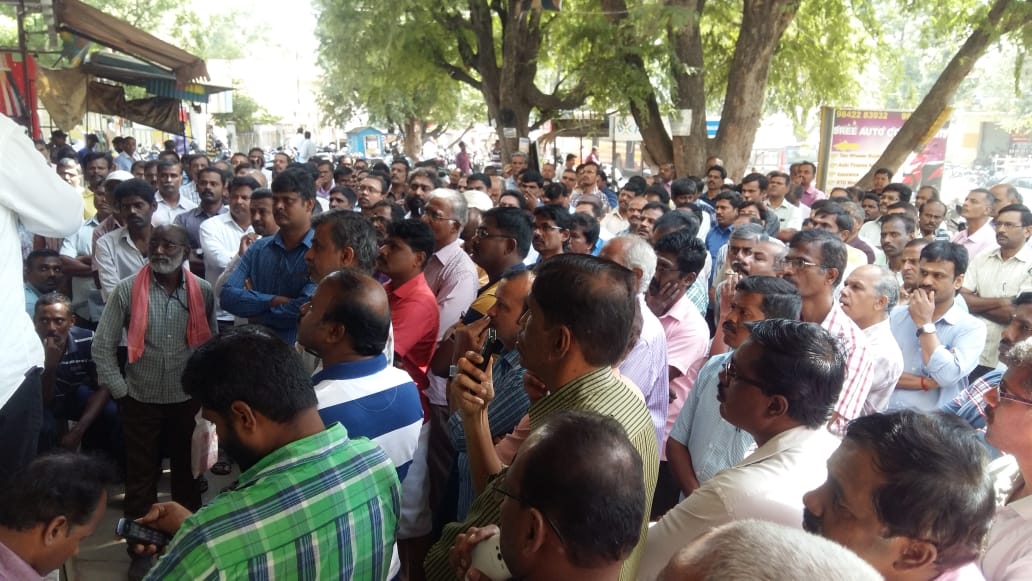
Source: TNLabour
August 21: Workers from the auto-parts manufacturer Pricol plant in Coimbatore, TN, went on a strike after the management failed to initiate dialogue for a wage agreement and withheld the dues while upholding the suspension of union members. Key demands included end to punishments, victimisation and denial of allowances/ dues to the workers, secret ballot elections to determine the majority union, among others. After 100 days of struggle, about 300 permanent workers ended their strike on December 4 after the management agreed to some of their demands. But the victory was short-lived as soon after joining back, over 300 of them were handed transfer orders.
December: After Pricol and Royal Enfield, now another auto-parts manufacturer in Tamil Nadu, LGB Rolon, resorted to transfers to break the workers’ union. After a six month strike, workers decided to go back to work in August only to face denial of work and now transfers.
December: In an exemplary show of working class unity and camaraderie, the workers of Maruti voluntarily contributed and raised Rs. 31,21,200 for the families of the 13 workers currently in jail serving life imprisonment.
September: Workers unfurled the red flag at the Japanese air conditioning factory Daikin in Rajasthan. Though mostly symbolic, this event marks the rise of the workers assertion and unity in the Rajasthan industrial belt not known historically for such class action.
October: Thousands of people took out rallies in West Bengal to protest against the rampant incidence of silicosis among stone quarry workers across the state.
July: The West Bengal Government was finally pressured to allow the Domestic Workers’ Organisations to file for union registration. In August, in a major victory for the domestic workers’ struggles in Tamil Nadu, the TN Government announced minimum wage of Rs 37 per hour for domestic workers. In October, domestic workers in Kolkata took to the streets in protest against the Kolkata Police’s advisories profiling the workers as habitual thieves.
Onwards into the New Year…
On 8-9 January 2019, Trade Unions from across the country have given a call for a nation-wide general workers’ strike against the Modi Government’s labour reforms.
Even though the Meghalaya miners remain trapped in the flooded coal mines in Jaintia hills, even as the entire working class of this country remains trapped under the State-Corporate iron fist, they seem to be gearing up for the crucial election year of 2019, faced with their steepest ever battles in history.
Feature image courtesy The Sydney Morning Herald

